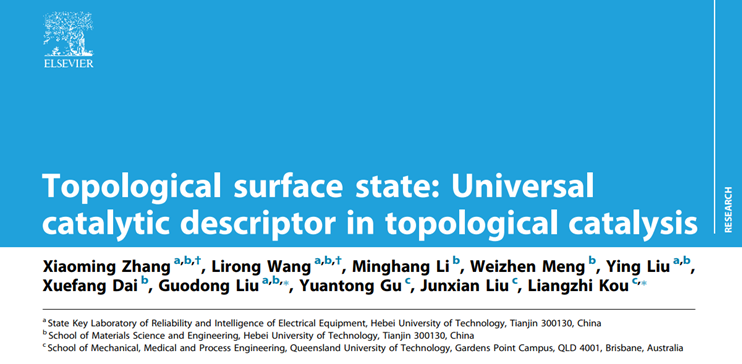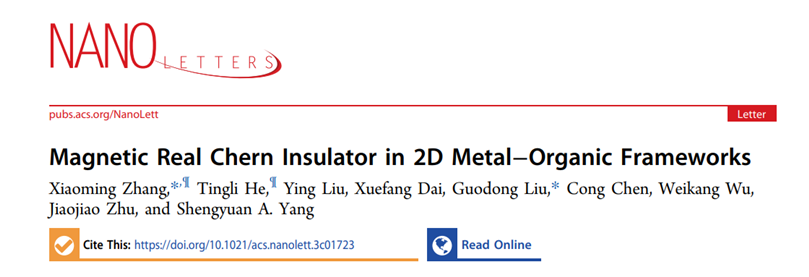The team of our university, the New Electronic Functional Materials, achieved significant milestones with the publication of important results in the prestigious international journal "Journal of the American Chemistry Society" in February 2023. Recently, the team has made further advancements in the field of topological electronics, and their research outcomes have been successively published in international journals,namely, Materials Today, Science Bulletin,Advanced Science, and Nano Letters.
The team has been dedicated to the research of new materials, properties, and applications in the field of topological electronics. Particularly, they have recently innovatively applied topological electronic materials to the field of electrocatalysis, providing new insights for the design and development of high-performance catalysts. In electrocatalysts, catalytic descriptors are important indicators that connect physicochemical interactions and catalytic performance in electrochemical processes. Currently, various catalytic descriptors established based on the d-band centere theory, such as coordination number, spin magnetic moment, bond length, and active site density, have been validated in various traditional electrocatalysts, serving as important criteria for guiding the design of high-performance electrocatalysts. However, as a nascent research field, the applicability of traditional catalytic descriptors to topological catalysis has not been verified.

Screenshotof Relevant Paper
Professor Zhang Xiaoming in this team collaborated with Professor Kou Liangzhi's team from the Queensland University of Technology in Australia, they conducted a systematic study on the applicability of traditional catalytic descriptors in topological catalysis for the first time. They proposed that the density of topological surface state could serve as a novel universal catalytic descriptor for applicable topological catalysts. Using metal diborides that host topological nodal lines as the research subject, they found that there is no relationship between the traditional catalytic descriptors that established based on d-band centers theory with their catalytic activity in the electrocatalytic hydrogen evolution reaction. However, the density of topological surface state directly related to topological parameters showed an excellent linear relationship with their catalytic activity. The establishment of this catalytic descriptor is not only significant for understanding the topological catalytic mechanism but also provides a new basis for designing high-performance topological catalysts.This work was published in May 2023 in the form of a research article in the international journal "Materials Today" (DOI: 10.1016/j.mattod.2023.05.002). Professor Zhang Xiaoming from our university is the first author, with our doctoral student Wang Lirong as a co-first author, and Professor Liu Guodong from our university and Professor Kou Liangzhi from the Queensland University of Technology as corresponding authors.
Magnetic two-dimensionaltopological materials integrated with nontrivial topological band characteristics, not only enriches the theoretical framework of condensed matter physics but also demonstrates tremendous prospects in the applications of energy, electronics, and information technology. Professor Zhang Xiaoming from our university, in collaboration with Associate Professor Wang Xiaotian from Southwest University and Professor Cheng Zhenxiang from the University of Wollongong in Australia, comprehensively summarized the latest progress in two-dimensional magnetic topological materials. The team systematically elucidated the fundamental theory, research advancements, material realization, potential applications, and the challenges in the future of these materials.

Screenshotof Relevant Paper
This work was published in the form of a review article in the Chinese journal Science Bulletin in November 2023 (DOI: 10.1016/j.scib.2023.09.004). Professor Zhang Xiaoming from our university is the first author, with Associate Professor Wang Xiaotian from Southwest University and our doctoral student He Tingli as co-first authors. Professor Liu Guodong from our university and Professor Cheng Zhenxiang from the University of Wollongong are the corresponding authors.

Screenshotof Relevant Paper
With the concept of higher-order topological insulators being proposed, they have gradually been discovered in various non-magnetic material systems. However, easily synthesizable material candidates are still lacking in natural magnetic material systems. Leveraging the ferromagnetic H-phase monolayer VS2, Professors Liu Ying and Liu Guodong discovered that higher-order topological insulator phase can excellently exhibit in this magnetic material, providing a solid platform for studying the unique properties arising from the combination of magnetism and higher-order topology. This work, for the first time, identified spin-polarized corner states in two spin channels of the ferromagnetic H-phase monolayer VS2. These corner states were characterized by quantized fractional corner charges. The study also confirmed the robustness of the corner states against symmetry breaking disturbances, significantly reducing the experimental challenges in verifying higher-order properties. This work was published online in July 2023 in the international journal Advanced Science (DOI: 10.1002/advs.202301952). Professor Liu Guodong from our university is the first author, and Professor Liu Ying is the corresponding author.

Screenshotof Relevant Paper
The realization of real Chern topological states has been a recent focus in condensed matter physics. These states have a distinct topological classification compared to traditional topological materials, exhibiting unique physical properties such as unconventional bulk-edge correspondence and non-abelian braiding effects. Recently, real Chern insulators have been proposed in some carbon-based materials. These materials are non-magnetic, and the spin-orbit coupling effect can be neglected. However, real Chern insulators have not been realized in magnetic systems with time-reversal symmetry breaking.
Professor Zhang Xiaoming collaborated with Dr. Chen Cong from the University of Hong Kong, Dr. Wu Weikang from Shandong University, and Professor Yang Shengyuan from the Singapore University of Technology and Design. They achieved, for the first time, the realization of magnetic real Chern insulators in a series of two-dimensional metal-organic framework materials. This work was published online on August 3, 2023, in the international journal Nano Letters (DOI: 10.1021/acs.nanolett.3c01723). Professor Zhang Xiaoming from our university is the first author and corresponding author, our doctoral student He Tingli is the co-first author, and Professor Liu Guodong from our university is the corresponding author of the paper.
The aforementioned research works are supported by the National Natural Science Foundation of China (NSFC) General Program, the Hebei Provincial Natural Science Foundation for Outstanding Youth, the State Key Laboratory ofReliability and Intelligence of Electrical Equipment of Hebei (Young Talent Project), and the PI Team Project
Articles links:
https://www.sciencedirect.com/science/article/abs/pii/S1369702123001384
https://www.sciencedirect.com/science/article/abs/pii/S2095927323006205
https://onlinelibrary.wiley.com/doi/full/10.1002/advs.202301952
https://onlinelibrary.wiley.com/doi/full/10.1002/advs.202301952
Author Profiles
Xiaoming Zhang(张小明),male, born in 1987, professor, doctoral supervisor, "YuanguangScholar" of the Hebei University of Technology. He earned his Ph.D. from the Institute of Physics, Chinese Academy of Sciences in January 2016. From 2016 to 2018, he conducted postdoctoral research at the Singapore University of Technology and Design. In March 2018, he joined the School of Materials Science and Engineering at Hebei University of Technology. His research focuses on the properties and applications of topological electronic materials. Currently, he hosts three National Natural Science Foundation projects and seven provincial and ministerial-level projects, including one with a contract value of 20 million yuan. He has published over 70 SCI papers as the first or corresponding author in international journals such as the Journal of the American Chemistry Society, Materials Today, and Science Bulletin. The total citation of his published papers exceeds 4900. He serves as a youth editor for the top journal Rare Metals in Category I of the Chinese Academy of Sciences. Honors and titles he owned include 131 Innovative Talents in Tianjin, Young Talent of Tianjin Youth Talent Project, and Excellent Young Scholar of Tianjin Innovative Talents Promotion Plan. He has been consecutively listed as one of the top 2% scientists globally by Stanford University from 2021 to 2023.
Ying Liu(刘影),female, professor, master's and doctoral supervisor, "Yuanguang Scholar" of Hebei University of Technology. She graduated from the Singapore University of Technology and Design in 2020, specializing in the study of interface electronic transport properties, topological material properties, and applications. She currently leads two projects from the National Natural Science Foundation, including the Youth Project and the General Project. She also hosts three Natural Science Foundations of Hebei Province. As the first/corresponding author, she has published over 40 SCI papers, including Physical Review Letters, Advanced Science, and Physical Review B…. Her papers have been cited over 2600 times in the past three years, with an h-index of 27.
Guodong Liu(刘国栋),Vice Dean of the School of Science at Hebei University of Technology, professor, master's and doctoral supervisor, currently serving as a director of the Tianjin Vacuum Society. He has received honors such as the New Century Talent by the Ministry of Education, one of the first batch of top-notch talents in Hebei Province, a special allowance expert of the Hebei Provincial Government, the first level of the "333 Talents Project" in Hebei Province, and one of the top 100 innovative talents in Hebei Province's universities. His research mainly involves the design, development, physical properties, and application promotion of new electronic functional materials. He has published over 180 SCI papers in journals such as JACS, Materials Today, Nano Letters, Advanced Science, AM, PRB, and APL. Among them, more than 50 papers are in Q1/TOP journals. The cumulative citation of his papers in top journals like Science and Physical Review Letters has reached 5000 times. He has led more than 10 national and provincial-level projects, including the National Natural Science Foundation. He has been granted 10 national invention patents. He has won two second prizes in the Hebei Provincial Natural Science Awards (ranked 1), and has been listed as one of the "Top 2% Scientists Globally" for three consecutive years.
Photo: Xiaoming Zhang
Article: By Xiaoming Zhang and Ying Liu